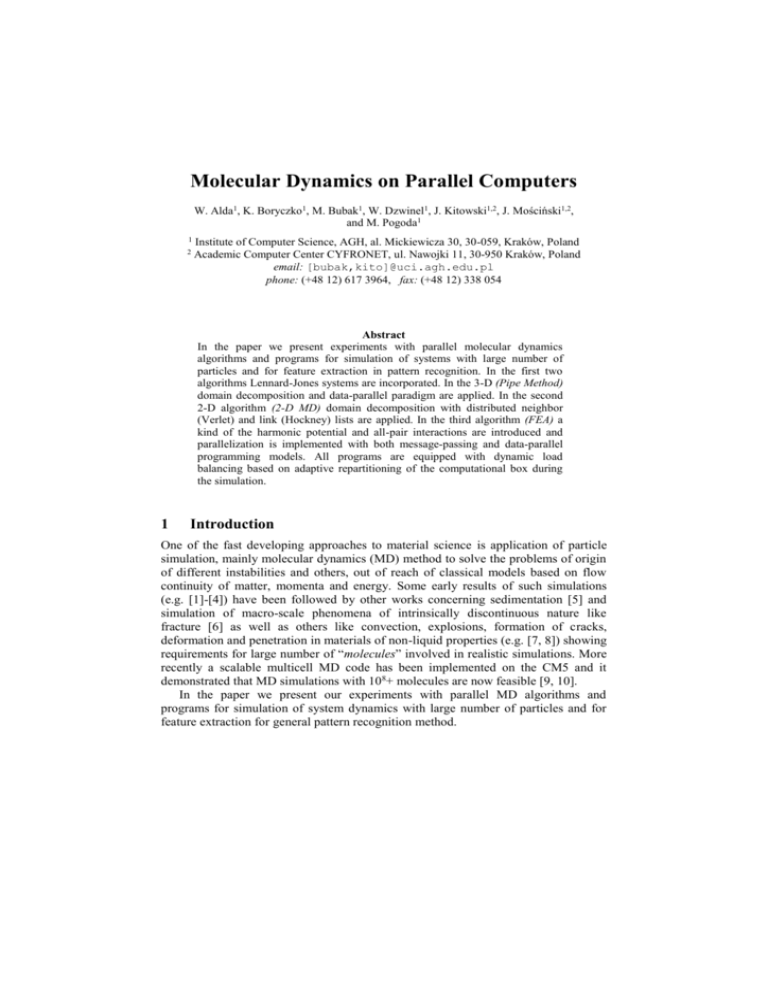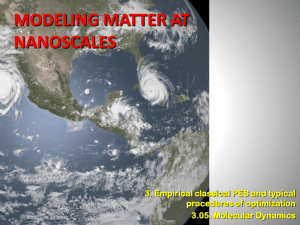cgw - ACK Cyfronet AGH
advertisement

Molecular Dynamics on Parallel Computers W. Alda1, K. Boryczko1, M. Bubak1, W. Dzwinel1, J. Kitowski1,2, J. Mościński1,2, and M. Pogoda1 1 2 Institute of Computer Science, AGH, al. Mickiewicza 30, 30-059, Kraków, Poland Academic Computer Center CYFRONET, ul. Nawojki 11, 30-950 Kraków, Poland email: [bubak,kito]@uci.agh.edu.pl phone: (+48 12) 617 3964, fax: (+48 12) 338 054 Abstract In the paper we present experiments with parallel molecular dynamics algorithms and programs for simulation of systems with large number of particles and for feature extraction in pattern recognition. In the first two algorithms Lennard-Jones systems are incorporated. In the 3-D (Pipe Method) domain decomposition and data-parallel paradigm are applied. In the second 2-D algorithm (2-D MD) domain decomposition with distributed neighbor (Verlet) and link (Hockney) lists are applied. In the third algorithm (FEA) a kind of the harmonic potential and all-pair interactions are introduced and parallelization is implemented with both message-passing and data-parallel programming models. All programs are equipped with dynamic load balancing based on adaptive repartitioning of the computational box during the simulation. 1 Introduction One of the fast developing approaches to material science is application of particle simulation, mainly molecular dynamics (MD) method to solve the problems of origin of different instabilities and others, out of reach of classical models based on flow continuity of matter, momenta and energy. Some early results of such simulations (e.g. [1]-[4]) have been followed by other works concerning sedimentation [5] and simulation of macro-scale phenomena of intrinsically discontinuous nature like fracture [6] as well as others like convection, explosions, formation of cracks, deformation and penetration in materials of non-liquid properties (e.g. [7, 8]) showing requirements for large number of “molecules” involved in realistic simulations. More recently a scalable multicell MD code has been implemented on the CM5 and it demonstrated that MD simulations with 108+ molecules are now feasible [9, 10]. In the paper we present our experiments with parallel MD algorithms and programs for simulation of system dynamics with large number of particles and for feature extraction for general pattern recognition method. 2 2.1 Characteristics of Parallel Algorithms Pipe Method The computational box applied in the study is a 3-D long cylinder. It is useful for studies of fluids and mixtures in microcapillaries or growth of optical fibers. The algorithm was originally developed for vector computers [11]. Short-range interactions defined by 12/6 Lennard-Jones pair potential are used with leap-frog algorithm for solving Newtonian equations of motion. Simulation of microcanonical ensemble is performed. Periodic boundary conditions are introduced along the cylinder axis only (in zdirection). Since the number of neighbors interacting with a given molecule is nearly constant, the integer cutoff number nC is introduced, where nC is a number of neighbours interacting potentially with a given particle. Particles in the cylinder are sorted due to their z coordinates and the index vector is set up on returning to original particles indices. For forces calculation the computational cylinder is stepwise shifted in respect to its copy to subsequent neighbouring particles from 1 to nC. 2.2 2-D MD Program Calculation of forces is always the most time consuming part of any MD program. In the 2-D MD program we have applied the Verlet neighbor-list [12] to speed up the evaluation of interactions between molecules as well as Hockney link-list and sorted lists to build the neighbor list. The neighbor list is reconstructed automatically. Equations of motion are solved using leap-frog algorithm. Tuning of the sequential program consisted in referencing large global arrays by locally declared pointers, assigning local variables to frequently used global ones and removing the effect of the cache on the performance by avoiding allocations of arrays of a size close to multiplicity of cache line length and sorting of particle data during simulation… 2.3 Feature Extraction by Molecular Dynamics Feature extraction (mapping) is such a transformation of N-dimensional space to lowdimensional E3 space which preserves in the best way mutual distances between cluster members. This may be achieved by finding the global minimum of the Sammon’s criterion function. The quality of the transformation is a distance between the global minimum to that found by mapping. Particles interact via Vij particleparticle pair potential Vij = k(rij2 – aij2)2, (1) where: k – the stiffness factor, k > 0, rij – the distance between particles i and j in E3, aij – the distance between particles i and j in RN. The sum of potentials for each pair of (i, j) gives the total potential energy of particles system Ep Minimization of Ep represents the Sammon's criterion. The system evolves according to the Newtonian equations of motion. The transient total force acting on a single particle i is equal to the gradient of potential energy. To reduce the numerical oscillation and assure energy dissipation the friction force is introduced. This is the principal condition to reach Ep minimum ... 3 Computers and Environments System name Nodes HP/Convex SPP1200/XA SPP1600/XA Intel Paragon XP/S 32 98 Interconnection two-layer – crossbar/ 1D torus 2D mesh System: version and environment SPP-UX: 3.2.129, C (6.4), ConvexPVM (3.3.10) OSF/1: 1.0.4, C, NX-2 (R4.5) 1.3.3, Fortran77 TMC CM5 896 data/control network fat/binary tree 3-D torus latency hiding CRAY T3D 512 IBM RS6K/320 SUN SparcStation2 2 Ethernet 2 network C Most CM Fortran 2.1/2.2 Options -O2 -O -Knoieee -O4 -Knoieee -O UNICOS 8.0.3 C 4.0.5, PVM Cray v. 3.0.0.2 AIX 3.2.4 SunOS 4.1 C, PVM (3.3.8) -O Tab. 1: Comparison of parallel computer systems and environments Main feature of three NUMA multiprocessor computers applied in the study are summarized in Tab. 1. 4 4.1 Program Performance The PIPE Method In Fig. 1 execution wall-clock time, r, per MD timestep and particle is presented for the Pipe Method for the both models of programming: domain decomposition and data-parallel. For the domain decomposition paradigm, for which ... 4.2 2-D MD Parallel Program Wall-clock r of the parallel program on homogeneous clusters of the SUN SPARCstation IPX, IBM RS/6000-320 and CONVEX Exemplar SPP 1200, SPP 1600 and Cray T3D is presented in Fig. 2. Fig. 1: Execution time for different number of computing nodes, K, for PIPE algorithm on network of workstations (NW), CM5 (CM), Paragon (PN) and SPP1200 (CX). Fig. 2: Execution time for the parallel 2-D MD program on virtual network computer and on Exemplar SPP 1200, SPP 1600 and Cray T3D; constant size problem – 131072 particles. Timings were done for the constant size problem, i.e. the number of particles indicated in Fig. 2 is the total number of particles in the computational box. Calculations on SPP 1200 and SPP 1600 were done on dedicated subcomplex with 24 and 16 processors, respectively. 5 Sample Results MD application is especially valuable when the fluctuations play predominant role in the system evolution, e.g. the hydrodynamical phenomena driven by Rayleigh-Taylor type of instabilities. The process of mixing of two fluids: heavier one placed above and lighter on the bottom is a good example. The system consists of two kinds of particles which form lighter and heavier fluids. The particles are placed in a 2-D rectangular box. Periodic boundary conditions are applied to vertical edges, while horizontal edges represent reflecting walls. Initially, the heavier fluid occupies the upper half of the box. Due to external gravity field acting downwards on every particle the motion of both layers starts. Fig. 3: Simulation of mixing of two fluids The MD simulations (see Fig. 3) have been performed for 2.8 x 10 6 particles on 128 processors of Cray T3D (at Minnesota Supercomputer Center). In Fig. 3 one may observe the situation after 105 timesteps. 6 Concluding Remarks We have elaborated two parallel 2-D/3-D short-range MD programs. The pipe method is used for studies of fluid properties in microcapillaries and test purposes while the second is highly optimized for production runs. Both algorithms turn out to be efficient in parallel implementation for moderate number of particles and computing nodes. The 2-D MD code is based on PVM and thus portable over a wide range of computer architectures like networked workstations and multiprocessors. When it was being developed the main objective was to make large simulations feasible by reducing the execution time and providing more memory for computer experiments. It is suitable for simulation of Lennard-Jones systems with large number of particles (106+) what is required for fluid flow and macroscopic phenomena investigation with MD. Important advantage of the parallel program is the load balancing procedure tuning dynamically distribution of the program data on processors to their current load which results in improvement of performance. MD approach can also be used as “natural solver” and applied straightforwardly to global minimum search. In this case we were able to use parallel systems efficiently by just adapting existing parallel MD algorithms and software. Acknowledgements. We are very grateful to Prof. David A. Yuen from Minnesota Supercomputer Institute and to Dr. Jeremy Cook from University of Bergen for supporting us with computer time. The support of ACC CYFRONET staff, in particular Mrs Z. Mosurska, Mr M. Pilipczuk and Dr. P. Wyrostek, was very helpful. This research was partially supported by the II Joint American-Polish M. Skłodowska-Curie Fund (MEN/NSF-94-193). References 1. Rapaport, D.: Microscale hydrodynamics: Discrete particle simulation of evolving flow patterns, Phys.Rev., A36, 7 (1987) 3288. 2. Koplik, J., Banavar, J.R., Willemsen, J.F.: Molecular dynamics of Poiseuille flow and moving contact lines, Phys. Rev. Lett., 60 (1988) 1282. 3. Cui, S.T., Evans, D.J.: Molecular dynamics simulation of two dimensional flow past a plate, Mol. Simul., 9 (1992) 179. 4. Rapaport, D.: Unpredictable convection in a small box: molecular dynamics experiments flow patterns, Phys.Rev., A46, 4 (1992) 1971. 5. Alda, W., Dzwinel, W., Kitowski, J., Mościński, J., and Yuen, D.: Convection driven by sedimentation using molecular dynamics approach, Hertzberger, B., Serazzi, G., (eds.), Proc. Int. Conf. High, Performance Computing and Networking, Milan, Italy, May 1995, LNCS 796, 678-683, Springer-Verlag, 1995. 6. Mora, P., Place, D.: A lattice solid model for the nonlinear dynamics of earthquakes, International Journal of Modern Physics C 4 (1993) 1059-1074. 7. Alda, W., Bubak, M., Dzwinel, W., Kitowski, J., Mościński, J.: Computational molecular dynamics at the Institute of Computer Science, AGH – Cracow, Poland, Supercomputer Institute Research Report UMSI 94/224 (1994). 8. Alda, W., Bubak, M., Dzwinel, W., Kitowski, J., Mościński, J., Pogoda, M., and Yuen D.: Fluid dynamics simulation with particles, in: Borcherds, P., Bubak, M., and Maksymowicz, A., (Eds.), Proc. of the 8 Joint EPS-APS Int. Conf. on Physics Computing, Krakow, September 17-21, 1996, Kraków, Poland, pp. 281-284, ACC CYFRONETKRAKÓW, Poland, 1996. 9. Beazley, D.M., Lomdahl, P.S.: Message-passing multi-cell molecular dynamics on the Connection Machine 5, Parallel Computing 20 (1994) 173-195. 10. Beazley, D.M., Lomdahl, P.S., Gronbech-Jensen, N., Giles, R., Tamayo, P.: Parallel algorithms for short-range molecular dynamics, World Scientific's Annual Reviews in Computational Physics, 3 (1995). 11. Mościński, J., Kitowski, J., Rycerz, Z.A., Jacobs, P.W.M.: A vectorized algorithm on the ETA 10-P for molecular dynamics simulation of large number of particles confined in a long cylinder, Comput. Phys. Commun., 54 (1989) 47. 12. Gupta, S.: Computing aspects of molecular dynamics simulation, Computer Physics Communication 70 (1992) 243-270. 13. Bubak, M., Mościński, J., Pogoda, M., Słota, R.: Load balancing for lattice gas and molecular dynamics simulations on networked workstations, Hertzberger, B., Serazzi, G., (eds.), Proc. Int. Conf. High Performance Computing and Networking, Milan, Italy, May 1995, LNCS 796, 329-334, Springer-Verlag, 1995.







